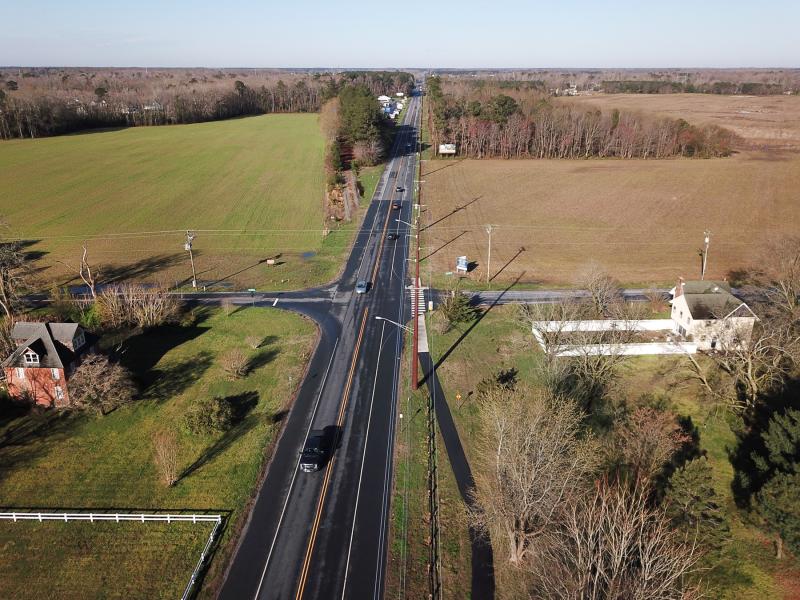Route 9 traffic on the rise
On average, 15,000 cars travel on Route 9 between Georgetown and Lewes each day.
With the corridor use expected to grow due to continued development, the Delaware Department of Transportation estimates that number will exceed 20,000 in the future.
“That is the common threshold being used to start to consider dualization,” said Whitman, Requardt and Associates consultant Steve Harr, noting there are also other factors to consider. Dualization is widening roadways to have multiple lanes.
Unlike Route 16 to the north, Route 9 does not see a large uptick in traffic during the summer months. According to recent data, daily traffic only increases 5% to 10% during the warmer months. On Route 16, summer traffic picks up by about 30%.
To learn where people are going on Route 9, DelDOT tracked 5,400 vehicles traveling eastbound toward Lewes. Only 2,100 cars, fewer than 40%, reached Five Points. The rest turned off to another road somewhere along the way. The study had similar findings for westbound traffic, as fewer than 3,000 of 7,200 tracked vehicles reached Georgetown.
This again differs from Route 16, which retained 60% of its vehicles between Route 113 and the traffic signal at Route 1 east of Milton.
Harr presented the data at a Feb. 13 meeting of the Coastal Corridors Committee. It was the committee’s third of four planned meetings. Previous meetings focused on data, and the Route 16 corridor between Ellendale and Route 1. The fourth meeting is scheduled for Monday, March 13, when the group will review improvement strategies. A spring workshop is also planned at a date to be determined.
At the Feb. 13 meeting, committee members reviewed the Route 9 corridor, discussing traffic data, proposed development, proposed and completed road projects, and general areas of concern.
The group determined there needs to be more interconnectivity between communities. Glenn Marshall of Sussex County Emergency Medical Services and the Lewes Fire Department said response times are often faster if they do not travel on Route 9. He said having communities interconnected would further improve response times.
Other members of the committee agreed, saying rarely do they reach the speed limit when driving on Route 9, and backups are common when drivers are attempting to make left turns.
Committee members would also like to see more coordination with Sussex County on projects, and the group understands dualization of Route 9 is likely in the future.
During a presentation to the Five Points Working Group Jan. 30, DelDOT Deputy Secretary and Chief Engineer Shante Hastings said dualization is already on the department’s radar, with funding planned for fiscal year 2029. The current plan is to dualize from Old Vine Road at The Vineyards community, home of the new Redner’s Fresh Market, to the Five Points area. At the Feb. 13 meeting, Harr showed the wait times at several intersections and the difference dualization would make.
About Coastal Corridors Committee
Most of Sussex County’s major arteries move vehicles north and south, but a few years ago, DelDOT determined east-west traffic was becoming more challenging and decided to identify all issues on the major roads. Initially, the study area focused on Route 9/404 and Route 16 from the Maryland line to the resort area. Due to projected volumes, the study area was reduced to just the east-west routes between Route 113 and Route 1, said Leah Kacanda, a planner for DelDOT consultant Whitman, Requardt and Associates.
Due to Maryland widening Route 404, the potential expansion of the Bay Bridge, continued development and the fact that Delaware beaches will continue to be an attraction, DelDOT determined proactive measures need to be taken for east-west routes in Sussex.
Kacanda said the goal is to ensure future traffic growth works for communities rather than harms them. The focus is on preserving transportation safety and mobility, maintaining quality of life for residents and ensuring continued economic competitiveness.
“We don’t want to be in a situation where people can’t get out of their driveways,” she said. “That wouldn’t be good for anyone.”
Unlike the Five Points Working Group, the Coastal Corridors Committee does not have voting powers. The committee is a group of local stakeholders who will develop high-level transportation strategies for consideration. Whereas the Five Points group made detailed recommendations, the Coastal Corridors Committee can identify potential problem areas and offer suggestions for where improvements are needed. DelDOT will consider those broad recommendations as future improvements are planned.

















































